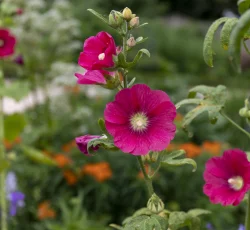
Heliotrope
Heliotropium arborescens
A fragrant addition to your summer border, this sturdy plant prefers well-drained soil and afternoon shade in the southern garden.
EXPLORE THIS PLANT
A fragrant addition to your summer border, this sturdy plant prefers well-drained soil and afternoon shade in the southern garden.
EXPLORE THIS PLANT
Helmar is a yellow and red tulip. Its red flames mimic the pattern of some of the broken tulips of the tulip mania.
EXPLORE THIS PLANT
Hollyhocks are old-fashioned cottage garden favorites for their height and cheerful flowers in a wide range of colors. Most require staking to support their heavy stems.
EXPLORE THIS PLANT
Honesty is an old fashioned plant with briliant pink flowers that give way to paper-thin silvery seedpods, hence its many common names.
EXPLORE THIS PLANT
The Hoop Petticoat is one of the smallest daffodils grown at Mount Vernon and is often crowded towards the front of the border for ease of viewing. It has unique flowers with large bells and slender, petite petals.
EXPLORE THIS PLANT
This versatile hydrangea tolerates a wide variety of conditions and is ideal for borders or natural areas. It benefits from an annual pruning in late winter to prevent the heavy blooms from flopping.
EXPLORE THIS PLANT
This tall plant is crowned with purple-pink flowers in the late summer. It is an American native and tolerates a wide variety of environmental conditions. Its height and bloom time can be controlled by by pruning it back by half when it reaches about two to three feet.
EXPLORE THIS PLANT
This delightful little flower is a harbinger of spring in many gardens, but also adds charm to a fall or winter garden depending on your region. The flowers are edible and can be used to wonderful effect on cakes and in salads.
EXPLORE THIS PLANT
This voluptuous annual is grown for its showy multicolored foliage in shades of green, yellow, and red.
EXPLORE THIS PLANT
Kale is a popular leafy green that can be used cooked or in salads. It is also used as an ornamental plant in fall gardens. Historically, coarser types have been used as animal fodder.
EXPLORE THIS PLANT